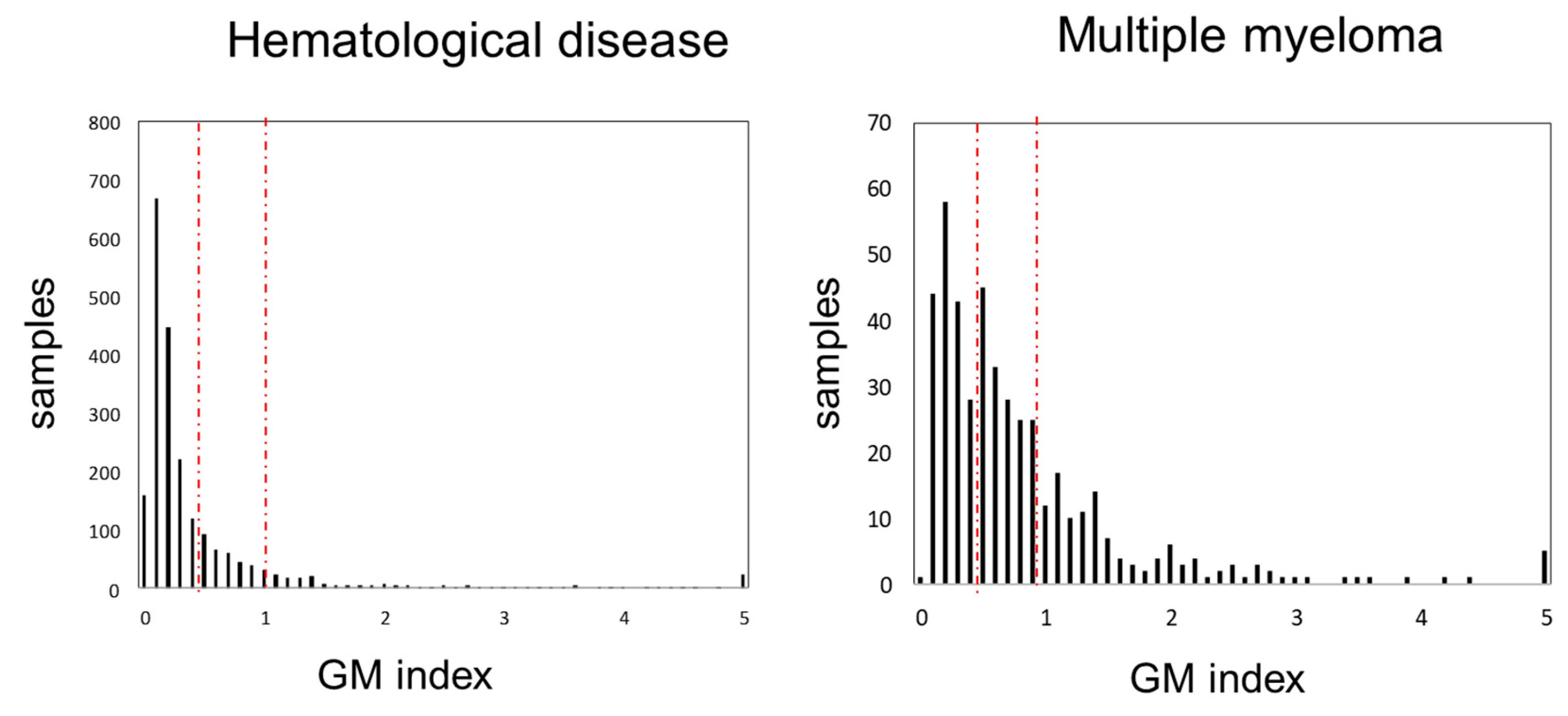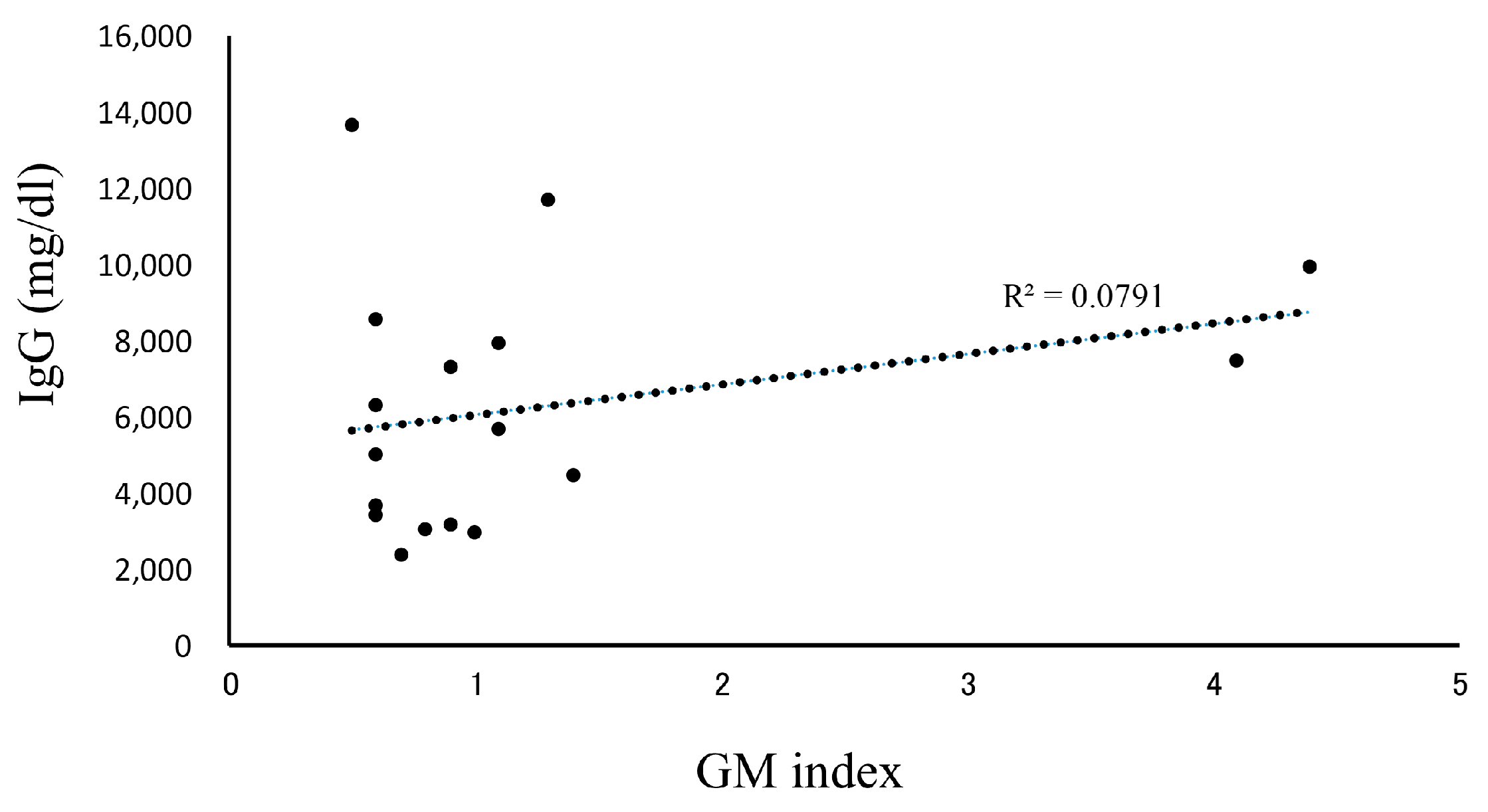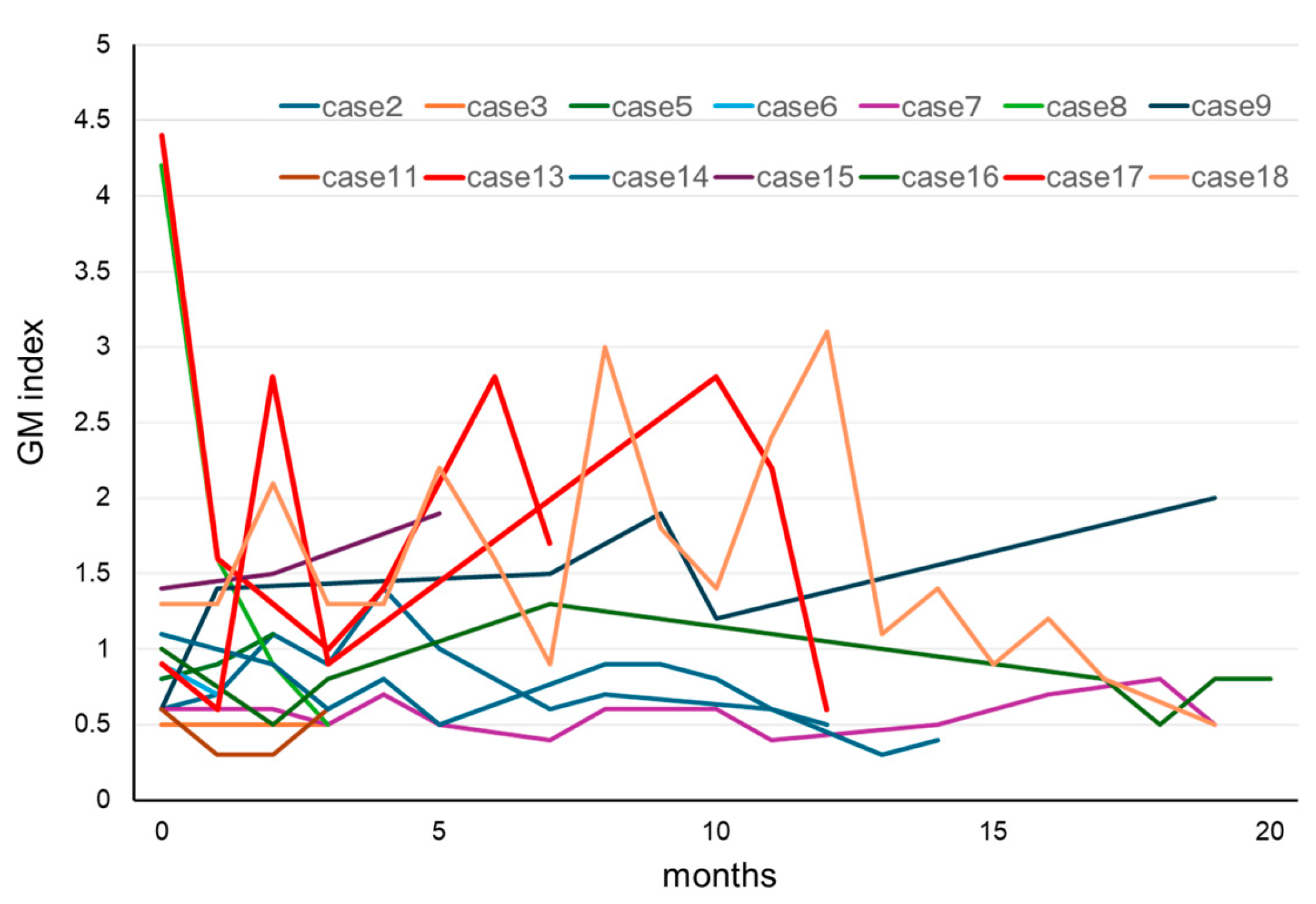False-Positive Galactomannan Test Results in Multiple Myeloma
Simple Summary
Abstract
1. Introduction
2. Materials and Methods
2.1. Study Design, Participants, and Ethics Statement
2.2. Serum Galactomannan Test
2.3. Galactomannan Test in Paraproteins
2.4. Statistical Analysis
3. Results
3.1. Patient Characteristics
3.2. Galactomannan Index in Hematological Diseases
3.3. Galactomannan Index in Multiple Myeloma
3.4. Clinical Course of the Galactomannan Index for Positive IgG-Type Multiple Myeloma
3.5. Galactomannan Index in Paraprotein
4. Discussion
4.1. False-Positive or Negative Galactomannan Test Results
4.2. Positivity of the Galactomannan Test in Multiple Myeloma
4.3. Transition of the Galactomannan Test Cutoff Value
4.4. Mechanisms of False-Positive Galactomannan Test Results in Multiple Myeloma
4.5. Limitations
5. Conclusions
Supplementary Materials
Author Contributions
Funding
Institutional Review Board Statement
Informed Consent Statement
Data Availability Statement
Acknowledgments
Conflicts of Interest
References
- De Pauw, B.; Walsh, T.J.; Donnelly, J.P.; Stevens, D.A.; Edwards, J.E.; Calandra, T.; Pappas, P.G.; Maertens, J.; Lortholary, O.; Kauffman, C.A.; et al. Revised definitions of invasive fungal disease from the European Organization for Research and Treatment of Cancer/Invasive Fungal Infections Cooperative Group and the National Institute of Allergy and Infectious Diseases Mycoses Study Group (EORTC/MSG) Consensus Group. Clin. Infect. Dis. 2008, 46, 1813–1821. [Google Scholar] [CrossRef] [PubMed]
- Donnelly, J.P.; Chen, S.C.; Kauffman, C.A.; Steinbach, W.J.; Baddley, J.W.; Verweij, P.E.; Clancy, C.J.; Wingard, J.R.; Lockhart, S.R.; Groll, A.H.; et al. Revision and Update of the Consensus Definitions of Invasive Fungal Disease From the European Organization for Research and Treatment of Cancer and the Mycoses Study Group Education and Research Consortium. Clin. Infect. Dis. 2020, 71, 1367–1376. [Google Scholar] [CrossRef] [PubMed]
- Jantunen, E.; Salonen, J.; Juvonen, E.; Koivunen, E.; Siitonen, T.; Lehtinen, T.; Kuittinen, O.; Leppä, S.; Anttila, V.J.; Itälä, M.; et al. Invasive fungal infections in autologous stem cell transplant recipients: A nation-wide study of 1188 transplanted patients. Eur. J. Haematol. 2004, 73, 174–178. [Google Scholar] [CrossRef]
- Fuchs, E.; Lavi, N.; Carasso, Y.; Oren, I.; Hardak, E. Invasive Pulmonary Aspergillosis in Multiple Myeloma patients: A sizeable diagnosis in the era of novel anti-myeloma therapies. Mycoses 2021, 64, 1298–1303. [Google Scholar] [CrossRef]
- Hachem, R.; Batista, M.V.; Kanj, S.S.; El Zein, S.; Haddad, S.; Jiang, Y.; Mori, N.; Vanderson, R.; Chaftari, A.M.; Raad, I. International Multicenter Experience in the Treatment Outcome of Invasive Aspergillosis in Immunocompromised Cancer Patients. Mediterr. J. Hematol. Infect. Dis. 2019, 11, e2019003. [Google Scholar] [CrossRef]
- Mikulska, M.; Furfaro, E.; Del Bono, V.; Raiola, A.M.; Ratto, S.; Bacigalupo, A.; Viscoli, C. Piperacillin/tazobactam (Tazocin) seems to be no longer responsible for false-positive results of the galactomannan assay. J. Antimicrob. Chemother. 2012, 67, 1746–1748. [Google Scholar] [CrossRef]
- Tortorano, A.M.; Esposto, M.C.; Prigitano, A.; Grancini, A.; Ossi, C.; Cavanna, C.; Cascio, G.L. Cross-reactivity of Fusarium spp. in the Aspergillus Galactomannan enzyme-linked immunosorbent assay. J. Clin. Microbiol. 2012, 50, 1051–1053. [Google Scholar] [CrossRef]
- Ng, T.Y.; Kang, M.L.; Tan, B.H.; Ngan, C.C. Case report: Enteral nutritional supplement as a likely cause of false-positive galactomannan testing. Med. Mycol. Case Rep. 2014, 3, 11–13. [Google Scholar] [CrossRef]
- Liu, W.D.; Lin, S.W.; Shih, M.C.; Su, C.L.; Wang, Y.W.; Lin, S.C.; Lee, Y.F.; Huang, H.H.; Chou, W.C.; Wu, U.I.; et al. False-positive Aspergillus galactomannan immunoassays associated with intravenous human immunoglobulin administration. Clin. Microbiol. Infect. 2020, 26, 1555.e9–1555.e14. [Google Scholar] [CrossRef]
- Hung, Y.H.; Lai, H.H.; Lin, H.C.; Sun, K.S.; Chen, C.Y. Investigating Factors of False-Positive Results of Aspergillus Galactomannan Assay: A Case-Control Study in Intensive Care Units. Front. Pharmacol. 2021, 12, 747280. [Google Scholar] [CrossRef]
- Mori, Y.; Nagasaki, Y.; Kamezaki, K.; Takenaka, K.; Iwasaki, H.; Harada, N.; Miyamoto, T.; Abe, Y.; Shimono, N.; Akashi, K.; et al. High incidence of false-positive Aspergillus galactomannan test in multiple myeloma. Am. J. Hematol. 2010, 85, 449–451. [Google Scholar] [CrossRef] [PubMed]
- Ko, J.H.; Peck, K.R.; Lee, J.Y.; Cho, S.Y.; Ha, Y.E.; Kang, C.I.; Chung, D.R.; Kim, K.; Kang, E.S.; Song, J.H. Multiple myeloma as a major cause of false-positive galactomannan tests in adult patients with cancer. J. Infect. 2016, 72, 233–239. [Google Scholar] [CrossRef] [PubMed]
- Abe, Y.; Narita, K.; Kobayashi, H.; Kitadate, A.; Takeuchi, M.; Matsue, K. Higher frequency of false-positive serum galactomannan tests among older subjects and the association with elevated serum immunoglobulin G levels. Mycoses 2019, 62, 773–779. [Google Scholar] [CrossRef] [PubMed]
- Kanda, Y. Investigation of the freely available easy-to-use software ‘EZR’ for medical statistics. Bone Marrow Transplant. 2013, 48, 452–458. [Google Scholar] [CrossRef]
- Stynen, D.; Sarfati, J.; Goris, A.; Prevost, M.C.; Lesourd, M.; Kamphuis, H.; Darras, V.; Latge, J.P. Rat monoclonal antibodies against Aspergillus galactomannan. Infect. Immun. 1992, 60, 2237–2245. [Google Scholar] [CrossRef]
- Leeflang, M.M.; Debets-Ossenkopp, Y.J.; Wang, J.; Visser, C.E.; Scholten, R.J.; Hooft, L.; Bijlmer, H.A.; Reitsma, J.B.; Zhang, M.; Bossuyt, P.M.; et al. Galactomannan detection for invasive aspergillosis in immunocompromised patients. Cochrane Database Syst. Rev. 2015, 2015, Cd007394. [Google Scholar] [CrossRef]
- Viscoli, C.; Machetti, M.; Cappellano, P.; Bucci, B.; Bruzzi, P.; Van Lint, M.T.; Bacigalupo, A. False-positive galactomannan platelia Aspergillus test results for patients receiving piperacillin-tazobactam. Clin. Infect. Dis. 2004, 38, 913–916. [Google Scholar] [CrossRef]
- Mattei, D.; Rapezzi, D.; Mordini, N.; Cuda, F.; Lo Nigro, C.; Musso, M.; Arnelli, A.; Cagnassi, S.; Gallamini, A. False-positive Aspergillus galactomannan enzyme-linked immunosorbent assay results in vivo during amoxicillin-clavulanic acid treatment. J. Clin. Microbiol. 2004, 42, 5362–5363. [Google Scholar] [CrossRef]
- Wheat, L.J.; Hackett, E.; Durkin, M.; Connolly, P.; Petraitiene, R.; Walsh, T.J.; Knox, K.; Hage, C. Histoplasmosis-associated cross-reactivity in the BioRad Platelia Aspergillus enzyme immunoassay. Clin. Vaccine Immunol. 2007, 14, 638–640. [Google Scholar] [CrossRef]
- Haran, A.; Temper, V.; Assous, M.; Bergel, M.; Chahanian, N.; Elinav, H.; Korem, M. False-positive galactomannan antigen testing in pulmonary nocardiosis. Med. Mycol. 2021, 59, 206–209. [Google Scholar] [CrossRef]
- Dalle, F.; Charles, P.E.; Blanc, K.; Caillot, D.; Chavanet, P.; Dromer, F.; Bonnin, A. Cryptococcus neoformans Galactoxylomannan contains an epitope(s) that is cross-reactive with Aspergillus Galactomannan. J. Clin. Microbiol. 2005, 43, 2929–2931. [Google Scholar] [CrossRef] [PubMed]
- Murashige, N.; Kami, M.; Kishi, Y.; Fujisaki, G.; Tanosaki, R. False-positive results of Aspergillus enzyme-linked immunosorbent assays for a patient with gastrointestinal graft-versus-host disease taking a nutrient containing soybean protein. Clin. Infect. Dis. 2005, 40, 333–334. [Google Scholar] [CrossRef] [PubMed]
- Girmenia, C.; Santilli, S.; Ballaro, D.; Del Giudice, I.; Armiento, D.; Mauro, F.R. Enteral nutrition may cause false-positive results of Aspergillus galactomannan assay in absence of gastrointestinal diseases. Mycoses 2011, 54, e883–e884. [Google Scholar] [CrossRef] [PubMed]
- Tomita, Y.; Sugimoto, M.; Kawano, O.; Kohrogi, H. High incidence of false-positive Aspergillus galactomannan test results in patients with aspiration pneumonia. J. Am. Geriatr. Soc. 2009, 57, 935–936. [Google Scholar] [CrossRef]
- Marr, K.A.; Laverdiere, M.; Gugel, A.; Leisenring, W. Antifungal therapy decreases sensitivity of the Aspergillus galactomannan enzyme immunoassay. Clin. Infect. Dis. 2005, 40, 1762–1769. [Google Scholar] [CrossRef]
- Maertens, J.; Verhaegen, J.; Lagrou, K.; Van Eldere, J.; Boogaerts, M. Screening for circulating galactomannan as a noninvasive diagnostic tool for invasive aspergillosis in prolonged neutropenic patients and stem cell transplantation recipients: A prospective validation. Blood 2001, 97, 1604–1610. [Google Scholar] [CrossRef]
- Maertens, J.A.; Klont, R.; Masson, C.; Theunissen, K.; Meersseman, W.; Lagrou, K.; Heinen, C.; Crépin, B.; Van Eldere, J.; Tabouret, M.; et al. Optimization of the cutoff value for the Aspergillus double-sandwich enzyme immunoassay. Clin. Infect. Dis. 2007, 44, 1329–1336. [Google Scholar] [CrossRef]
- Biewenga, J.; Daus, F.; Modderman, M.L.; Bruin, G.M. Binding of human IgA myeloma proteins to protein A. Evidence for different binding mechanisms. Immunol. Commun. 1982, 11, 189–200. [Google Scholar] [CrossRef]
- Akerström, B.; Björck, L. Protein L: An immunoglobulin light chain-binding bacterial protein. Characterization of binding and physicochemical properties. J. Biol. Chem. 1989, 264, 19740–19746. [Google Scholar] [CrossRef]
- Haas, I.G.; Wabl, M. Immunoglobulin heavy chain binding protein. Nature 1983, 306, 387–389. [Google Scholar] [CrossRef]
- Woods, G.; Miceli, M.H.; Grazziutti, M.L.; Zhao, W.; Barlogie, B.; Anaissie, E. Serum Aspergillus galactomannan antigen values strongly correlate with outcome of invasive aspergillosis: A study of 56 patients with hematologic cancer. Cancer 2007, 110, 830–834. [Google Scholar] [CrossRef] [PubMed]
- Nouér, S.A.; Nucci, M.; Kumar, N.S.; Grazziutti, M.; Barlogie, B.; Anaissie, E. Earlier response assessment in invasive aspergillosis based on the kinetics of serum Aspergillus galactomannan: Proposal for a new definition. Clin. Infect. Dis. 2011, 53, 671–676. [Google Scholar] [CrossRef] [PubMed]
- Cruciani, M.; Mengoli, C.; Loeffler, J.; Donnelly, P.; Barnes, R.; Jones, B.L.; Klingspor, L.; Morton, O.; Maertens, J. Polymerase chain reaction blood tests for the diagnosis of invasive aspergillosis in immunocompromised people. Cochrane Database Syst. Rev. 2015, 9, Cd009551. [Google Scholar] [CrossRef]
- Wang, X.; Guo, G.; Cai, R.; He, P.; Zhang, M. Utility of serum galactomannan antigen testing combined with chest computed tomography for early diagnosis of invasive pulmonary aspergillosis in patients with hematological malignancies with febrile neutropenia after antifungal drug treatment. J. Int. Med. Res. 2019, 47, 783–790. [Google Scholar] [CrossRef]



| Patients | Samples | Positive (≥0.5) Samples | Positive (≥0.5) Rate | Positive (≥1.0) Samples | Positive (≥1.0) Rate | |
|---|---|---|---|---|---|---|
| Total | 330 | 2155 | 540 | 25% | 235 | 10.9% |
| MM | 77 | 453 | 279 | 61.3% | 111 | 24.5% |
| DLBCL | 74 | 313 | 63 | 20% | 29 | 9.3% |
| AML | 52 | 533 | 54 | 10.1% | 23 | 4.3% |
| T-cell lymphoma | 16 | 73 | 5 | 6.8% | 3 | 4.1% |
| FL | 12 | 51 | 15 | 29% | 4 | 7.8% |
| ALL | 12 | 91 | 6 | 6.6% | 0 | 0 |
| AA | 12 | 75 | 5 | 6.7% | 4 | 5.3% |
| CML | 10 | 145 | 7 | 4.8% | 2 | 1.4% |
| MDS | 10 | 70 | 14 | 20% | 6 | 8.6% |
| ATL | 9 | 56 | 5 | 8.9% | 0 | 0 |
| MCL | 6 | 61 | 23 | 37.7% | 12 | 19.7% |
| Others | 40 | 234 | 64 | 27.6% | 61 | 26.1% |
| Patients with MM (N = 77) | Positive GM Index (≥0.5) at Diagnosis of MM (N = 23) | GM Index Measured During MM Treatment (N = 54) | |
|---|---|---|---|
| Samples | 453 | 182 | 271 |
| Age—years, median (IQR) | 64 (58.0–71.0) | 65 (61.5–69.5) | 64 (54.25–71) |
| Female sex, -n (%) | 35 (45.5%) | 9 (39.1%) | 26 (48.1%) |
| Type | |||
| IgG, -n (%) | 44 (57.1%) | 18 (78.3%) | 26 (48.1%) |
| IgA, -n (%) | 12 (15.6%) | 1 (4.3%) | 11 (20.4%) |
| BJP, -n (%) | 13 (16.9%) | 2 (8.7%) | 11 (20.4%) |
| IgD, -n (%) | 7 (9.1%) | 2 (8.7%) | 6 (11.1%) |
| Nonsecretory, -n (%) | 1 (1.3%) | 0 (0.0%) | 1 (1.9%) |
| GM index median (IQR) | 0.82 (0.3–1.0) | 1.11 (0.6–1.4) | 0.61 (0.2–0.7) |
| GM index ≥ 0.5 samples, (%) | 279 (61.6%) | 155 (85.2%) | 124 (45.8%) |
| GM index ≥ 1.0 samples, (%) | 111 (24.5%) | 76 (41.8%) | 47 (17.3%) |
| Case | Age·Sex | GM Index | IgG | Host Factor | Clinical Factor | Diagnosis (EORTC/MSG 2008) | Diagnosis (EORTC/MSG 2020) | Initial Treatment |
|---|---|---|---|---|---|---|---|---|
| 1 | 63F | 0.6 | 4988 | Hematologic malignancy (multiple myeloma) | − | False-positive | No IFD | VAD |
| 2 | 65M | 0.6 | 3429 | − | False-positive | No IFD | HDD | |
| 3 | 61M | 0.5 | 13629 | − | False-positive | No IFD | HDD | |
| 4 | 64F | 1.1 | 5661 | − | False-positive | False-positive | HDD | |
| 5 | 72M | 0.8 | 3042 | − | False-positive | No IFD | BD | |
| 6 | 77M | 0.9 | 7286 | − | False-positive | No IFD | MP | |
| 7 | 72M | 0.6 | 6308 | − | False-positive | No IFD | MP | |
| 8 | 64F | 4.1 | 7451 | − | False-positive | False-positive | BD | |
| 9 | 57M | 0.6 | 8565 | − | False-positive | No IFD | VAD | |
| 10 | 73F | 0.8 | 4292 | + ※ | Probable | No IFD | VAD | |
| 11 | 63M | 0.6 | 3655 | − | False-positive | No IFD | BD | |
| 12 | 64F | 0.7 | 2379 | − | False-positive | No IFD | HDD | |
| 13 | 61F | 4.4 | 9928 | − | False-positive | False-positive | HDD | |
| 14 | 70M | 1.1 | 7923 | − | False-positive | False-positive | MP | |
| 15 | 69M | 1.4 | 4441 | − | False-positive | False-positive | MP | |
| 16 | 51M | 1.0 | 2939 | − | False-positive | False-positive | VAD | |
| 17 | 70F | 0.9 | 3167 | − | False-positive | No IFD | VAD | |
| 18 | 66F | 1.3 | 11674 | − | False-positive | False-positive | VAD |
Disclaimer/Publisher’s Note: The statements, opinions and data contained in all publications are solely those of the individual author(s) and contributor(s) and not of MDPI and/or the editor(s). MDPI and/or the editor(s) disclaim responsibility for any injury to people or property resulting from any ideas, methods, instructions or products referred to in the content. |
© 2025 by the authors. Licensee MDPI, Basel, Switzerland. This article is an open access article distributed under the terms and conditions of the Creative Commons Attribution (CC BY) license (https://creativecommons.org/licenses/by/4.0/).
Share and Cite
Nakamura, S.; Maeda, Y.; Sumitani, R.; Oura, M.; Sogabe, K.; Yagi, H.; Fujii, S.; Harada, T.; Matsuoka, K.-i.; Miki, H. False-Positive Galactomannan Test Results in Multiple Myeloma. Diseases 2025, 13, 118. https://doi.org/10.3390/diseases13040118
Nakamura S, Maeda Y, Sumitani R, Oura M, Sogabe K, Yagi H, Fujii S, Harada T, Matsuoka K-i, Miki H. False-Positive Galactomannan Test Results in Multiple Myeloma. Diseases. 2025; 13(4):118. https://doi.org/10.3390/diseases13040118
Chicago/Turabian StyleNakamura, Shingen, Yusaku Maeda, Ryohei Sumitani, Masahiro Oura, Kimiko Sogabe, Hikaru Yagi, Shiro Fujii, Takeshi Harada, Ken-ichi Matsuoka, and Hirokazu Miki. 2025. "False-Positive Galactomannan Test Results in Multiple Myeloma" Diseases 13, no. 4: 118. https://doi.org/10.3390/diseases13040118
APA StyleNakamura, S., Maeda, Y., Sumitani, R., Oura, M., Sogabe, K., Yagi, H., Fujii, S., Harada, T., Matsuoka, K.-i., & Miki, H. (2025). False-Positive Galactomannan Test Results in Multiple Myeloma. Diseases, 13(4), 118. https://doi.org/10.3390/diseases13040118






